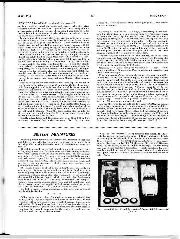
British Miniatures
Following recent references to German and American model cars and kits, we are delighted to be able to accord warm praise for a British product of this kind—the Autocraft miniature…
THE JAMESON-GILLETT SUPERCHARGER
The Jameson-Gillett supercharger, which is used on the Jameson engine and which is also marketed as a separate com
ponent, deserves a special description. It has a single rotor, and a ribbed casing of normal design. The rotor is disposed to one side of this, and pressure is produced by the reduction in volume included between the blades as they approach the outlet port. The rotor is a steel forging formed integral with its shaft. It has four radial slots in which the four spring-steel blades slide, with a centre portion of reduced diameter. A steel ring is carried on this part, and bears on the underside of the
blades, moving them to their correct positions as the rotor turns. The blades bear on silicon steel cups pressed into the blower casing, and are maintained at their correct clearance with the minimum of friction. At one end of the shaft a square plate carrying four pegs is fixed. A second plate lies parallel to this, with four movable
bushes eccentrically drilled. The motion of the second plate is communicated through rods which pass through the rotor to the controlling ring in the centre. When the blower is running at normal engine speed, centrifugal force keeps the blades in contact with the bearing cups, and the mechanism is
and the controlling mechanism is never heavily loaded.
Two small oil pumps are used, one to lubricate the movable bushes. and the other, which is controlled by the throttle, mixes oil with petrol and pumps it to the carburetter ready to be sucked into the supercharger. The amount passed when idling or running down hill with a partly closed throttle is neglegible. and oiling-up troubles are avoided. The supercharger builds up a good pressure at surprizingly low speeds, and a typical model gives
8 lbs. at 1,000 r.p.m.., and 10-12 lbs. at 4,500 r.p.m. Jameson Gillett superchargers are marketed at competitive prices by G.11ett, Stephen & Co., Ltd., Atlas Works, Little Bookham, Surrey.